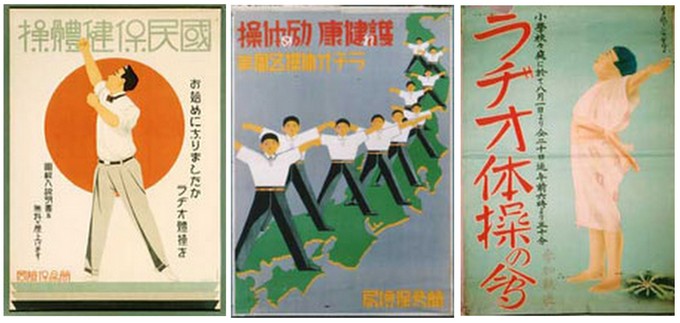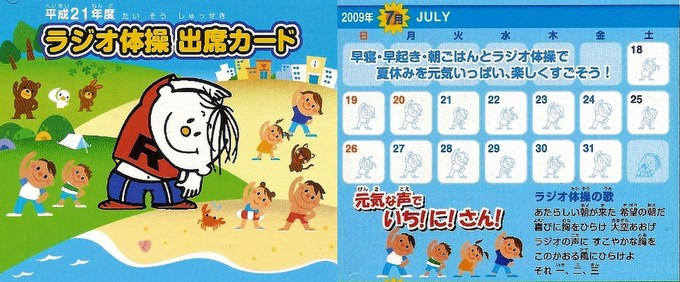Rajio Taisou ラジオ体操, or “radio exercises” is an integral (if slightly dorky) part of Japanese culture. You’ve probably come across it even if you don’t live in Japan – it pops up all the time in anime and movies (I myself first stumbled upon it in Studio Ghibli’s Omoide Poro Poro おもいでぽろぽろ). Plus, I’m almost certain there was a rooftop rajio taiso scene in Heroes a few years ago… heck, it’s even in Animal Crossing!
If you haven’t heard of rajio taiso, it’s basically a set of simple calisthenics done to piano music, and it’s broadcast almost daily by the NHK. There are currently three official versions: one for men and women of all ages, one to increase physical strength, and one that can be done while seated (for differently-abled persons and the elderly). There are also at least as many parodies, such as the merci taiso in the film Megane めがね, or “Glasses.”
A Brief History of Rajio Taiso

Surprisingly, despite being a Japanese cultural institution, rajio taiso is actually a foreign import.
In the early 1920s, Metlife, Inc. sponsored the broadcast of radio calisthenics by the now-defunct WGI (AM) in Massachusetts. Visiting employees from the postal life insurance division of Japan’s also now-defunct Ministry of Communications and Transportation (teishinshou 逓信省) thought it was brilliant, and brought the idea home with them.
The first rajio taiso was broadcast in Tokyo in 1928, just in time to commemorate the coronation of Emperor Hirohito – and the rest, as they say, is history.
Rajio Taiso Today

Besides a brief period following WWII where it was banned for being too militaristic, rajio taiso is now broadcast several times a day via radio and TV throughout Japan.
The obvious benefits of rajio taiso, namely increased flexibility, and improved general health and well-being, makes it a common sight at school sports days. It’s also practised by children during the summer holidays – all the cool kids have perfect rajio taiso attendance cards, don’t you know?
It’s not uncommon to see rajio taiso being practised in the Japanese workplace, as it also fosters morale and instils a sense of group unity. However, there are always two sides (or more) to every story – put another way, rajio taiso can be used to affirm the importance of the group over, and at the expense of, the individual.
The Tale of Tanaka-san
Tetsuro Tanaka was once an engineer for OKI, a telecommunications equipment manufacturer. He was also a very vocal union activist who strongly objected the redundancies of 1350 of his former colleagues, and criticized OKI’s labour policies.
The following year, OKI introduced rajio taiso, to be performed before work in unpaid time. Again, Tanaka-san strongly objected and refused to participate; he felt it was a humiliating and demeaning test of loyalty to OKI. As a result, his pay was cut, and he was given the option (read: ultimatum) to transfer to a distant factory. Once again, he refused – and was summarily sacked. That was in 1981; he has been demanding an apology and a reinstatement every day since. That’s over 30 years ago.
Tanaka-san’s struggle is the subject matter of the documentary “Tanaka-san Will Not Do Callisthenics,” which lets us get some idea of the cost of individualism and non-conformity in Japanese society.
Nowadays Tanaka-san makes a living as a guitar tutor, and I daresay he’s quite good at it. Part of Tanaka-san’s protests include playing guitar and singing outside the OKI company gate daily for half an hour, and on the monthly anniversary of his dismissal, by singing the entire day.
What strikes me the most is just how lonely it can be in Japan, to be the nail that refuses to be hammered down. That, and Tanaka-san’s incredible tenacity.
Give Tanaka-san some love:
